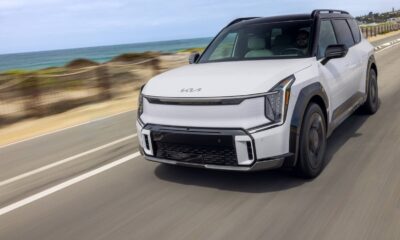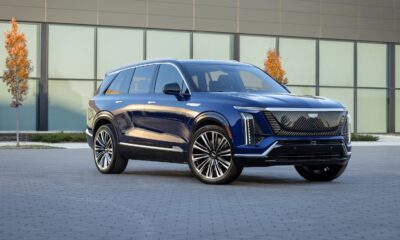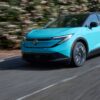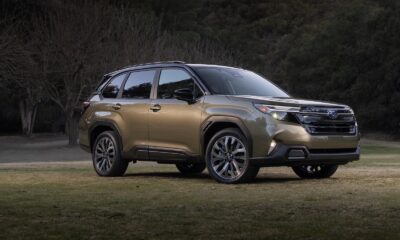Car Reviews
The 2025 GMC Hummer EV: RARE EARTH METAL
The 2025 GMC Hummer EV:
RARE EARTH METAL
The 2025 GMC Hummer EV is unapologetically large, brash, and exacting in its purpose. It’s not a compromise—it’s a declaration: scale, capability, and electric ambition rolled into one.
With base pricing near $96,000 and Edition 1 examples often nudging past $110,000 (before striking, five-figure dealer discounts), it’s aimed at a rare but clear-minded buyer wanting genuine off-road muscle, supercar-level acceleration, and a vehicle that makes a statement.
Frankly, I watched the launch of this and similar vehicles like the Ford Lightning with two questions in mind. The first was why manufacturers were willing to commit billions of dollars to battery factories when it seemed clear that the technology was in its infancy. But, I thought, GM and Ford executives know more than I, so what the heck?
My other concern was the industry’s strategy of applying skim theory, or price skimming, a marketing strategy where companies launch a new product at nosebleed price to capture early adopters willing to pay a premium, then gradually lower the price to attract more price-sensitive buyers. It works great in consumer electronics, says the man who waits for the latest and greatest in phones and computers so he can buy a brand-new but older model at a fraction of the cost.
The argument for EVs, however, is that they are far more cost-effective to own and use than fossil-fueled vehicles. Or at least they should be. Instead, the Big 3 painted themselves into a corner where EVs grew to be seen as something for the (liberal) elite, generating a negative vibe that will take decades to overcome.
Indeed, the market has cooled. Early hype pushed resale prices into nosebleed territory; today, heavy discounts are typical. Dealers have posted rebates of more than $40,000 on loaded examples as inventory builds. Loaner and demo programs have put lightly used units back on lots. For buyers who waited, patience can translate to five-figure savings. For the brand, it’s a reminder that spectacle must eventually meet demand.
GM’s broader EV ambitions are retrenching, and Ultium—the battery platform underpinning the Hummer—is not immune:
- Lordstown layoffs: GM confirmed 550 permanent job cuts at the Ultium Cells plant in Ohio, plus 850 temporary layoffs, citing slower EV adoption.
- Spring Hill furloughs: The Tennessee Ultium facility will furlough about 700 workers as production pauses for upgrades.
- Factory Zero cuts: GM eliminated 1,200 positions at its Detroit EV assembly plant, part of a larger downsizing of more than 3,400 jobs across EV and battery operations.
GM says it is aligning capacity with cooling demand, but demand is unlikely to go anywhere until manufacturers start offering the public electric vehicles they enjoy driving and can afford. (Looking at you, 2026 Nissan Leaf).
Exterior: brutalism with purpose
The Hummer EV doesn’t try to be subtle. Upright greenhouse, squared fenders, and vertical lighting read like purposeful aggression rather than aerodynamic finesse. It’s a rolling fortress compared with the Rivian R1S’s clean minimalism or the Model X’s sleek lines.
A nearly vertical windshield emanates militarism and power, but the look comes at a price: horrible aerodynamics—the single most significant variable in fuel consumption. Wind buffeting at the A-pillars drowns out conversation and muffles the sound system. Those who enjoy sitting in the driveway rockin’ and rollin’ to music will love this SUV; on the road, not so much.
The Hummer EV’s coefficient of drag is about 0.50—worse than rivals like the Rivian R1T (0.30) or Tesla Cybertruck (0.38). Combined with its massive frontal area and curb weight exceeding 9,000 pounds, this vehicle consumes energy quickly at highway speeds.
While its oversized 217 kWh battery allows GM to quote approximately 314 miles of range, real-world efficiency is poor: the Hummer EV delivers fewer miles per kWh than nearly any other EV on the market. In practice, expect the range to fall sharply with aggressive driving or sustained interstate cruising.
We took the GMC EV 93 miles up I-30 to a favored trail on Lake DeGray. Bringing the vehicle up to full charge from halfway cost $60 at the only working Level 3 charger we could find. Though we stayed close to the speed limit, interstate speeds caused the EV to gobble electrons faster than Cookie Monster with an oven-fresh batch of chocolate chip goodies.
Those aren’t crumbs falling from his mouth; they are $20 bills.
It took another $40 to get us home. Add in money spent shopping and eating while waiting for a charge, and it was easily a $150 hike. The same trip in my Highlander Hybrid consumes less than $20 of gasoline.
Performance and driving experience
The headline numbers are cinematic: a tri-motor setup offering nearly 1,000 horsepower and a 0–60 time in the mid-3-second neighborhood. Off the line, the Hummer EV doesn’t nudge—it yanks.
CrabWalk’s four-wheel steering earns its keep in tight terrain, and one-pedal driving, combined with ground clearance and durable underbody hardware, gives absolute confidence off-road.
Interior and tech: durable and theatrical
Inside, the Hummer EV blends rugged materials with a show-ready tech stack. Washable surfaces and configurable storage feel sensible; front-row space is generous, while the battery pack reduces second-row legroom and cargo space compared with leaner rivals.
Tech is prominent: a 13.4-inch infotainment screen and a 12.3-inch digital cluster are crisp and customizable. The system responds well but takes a little time to master. Over-the-air updates via GM’s Ultifi platform are a pragmatic advantage.
Practical touches underline the theatrics: removable Infinity Roof panels, a MultiPro tailgate with pass-through window, and substantive underbody armor that isn’t just for show. GMC’s design here favors bold geometry and functional heft over elegance.
Driver-assist features include Super Cruise—still one of the most confident hands-free options for divided highways—plus adaptive cruise, lane keep, and automatic emergency braking. Compared with Rivian’s restrained, Scandinavian approach, GMC’s cabin leans theatrical: if you like a bit of stagecraft, you’ll enjoy the spectacle.
Safety
The Hummer EV carries GM’s full safety suite: automatic emergency braking, pedestrian detection, lane keeping assist, and blind spot monitoring. Super Cruise adds semi-autonomous capability. Federal crash ratings are pending, but the vehicle’s mass and structure suggest strong passive protection.
Pricing and value: pick your excess
Trim choices map directly to appetite for capability and flair.
- EV2 — Starting near $79,995. Dual motors, ~250+ mile range, basic off-road kit; the nameplate without the whole circus.
- EV2X — Starting near $89,995. Adds adaptive air, four-wheel steering, and better charging—practical without going complete Omega.
- EV3X — Starting near $99,995. Tri-motor, torque vectoring, Watts to Freedom launch mode, and the complete off-road suite; the best balance of performance and capability.
- Edition 1 — Starting near $110,295 (commonly discounted). Premium finishes, unique badging, and every option box checked; once a six-figure resale legend, now increasingly offered with five-figure dealer discounts.
Value strategy: the EV3X is often the sweet spot. Look for low-mile loaners and demo units for the best bargains. Beware the EV2 if you need CrabWalk or robust, fast charging hardware—those features are not included at the bottom rung.
Huge discounts are likely to continue. At the end of October, more than 4,700 Hummer EVs were sitting largely ignored on dealer lots.
Bottom line
Buying a discounted Hummer EV is a bit like picking up a circus elephant on clearance: you’ll get jaw-dropping strength, a few party tricks, and the ability to stop traffic just by showing up.
Compared to an average $60,000 pickup, the advantages are obvious—supercar acceleration, off-road theatrics, and tech that makes you feel like Tony Stark. The disadvantages are equally clear: charging costs that rival steakhouse tabs, efficiency that makes a Highlander Hybrid look saintly, and a footprint that treats parking lots like tightrope acts.
And looming over it all is GM’s retrenchment from Ultium. Layoffs, furloughs, and factory cuts remind us that even the boldest platforms are subject to market gravity.
The Hummer EV towers as a colossus, but in the age of constraints, it carries caveats: spectacular, discounted, and tethered to a corporate strategy that’s learning the hard way that excess has limits.







































